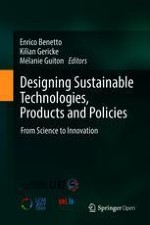Open Access 2018 | Open Access | Buch

Designing Sustainable Technologies, Products and Policies
From Science to Innovation
herausgegeben von: Dr. Enrico Benetto, Dr. Kilian Gericke, Dr. Mélanie Guiton
Open Access 2018 | Open Access | Buch

herausgegeben von: Dr. Enrico Benetto, Dr. Kilian Gericke, Dr. Mélanie Guiton
This book provides insight into the implementation of Life Cycle approaches along the entire business value chain, supporting environmental, social and economic sustainability related to the development of industrial technologies, products, services and policies; and the development and management of smart agricultural systems, smart mobility systems, urban infrastructures and energy for the built environment. The book is based on papers presented at the 8th International Life Cycle Management Conference that took place from September 3-6, 2017 in Luxembourg, and which was organized by the Luxembourg Institute of Science and Technology (LIST) and the University of Luxembourg in the framework of the LCM Conference Series.
This book is open access under a CC BY license